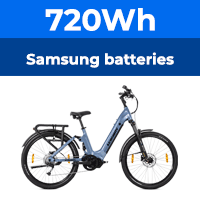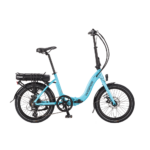I'm afraid the car analogy isn't relevant Bob, also sticking to the standard you suggest doesn't get near to matching the real world situation and I'm afraid it is that difficult to devise a standard, indeed it's impossible.
Our bikes are human. electric hybrids, so not comparable to other vehicles and impossible to measure.
See what I posted on this a few days ago on this subject to
read that detail.
.
OK Flecc – so you think my analogy is irrelevant – I`ll not take that personally! Thanks for directing me to your earlier posts - I had read them previously and I understand what you are writing.
The car anaology works for me and I thought I`d share. The point I was trying to make was that a standard baseline is helpful, even though I appreciate real world performance will not be the same thing – it least I know all cars have been tested the same way. I am happy with the fact I get between 30 and 60+ mpg depending on how I use the car.
I am similarly happy I can almost use up both my batteries on a 40 mile commute, or have over three quarters their capacity left depending on the route I choose, the weight I carry, the speed I set the dial assist to and the amount I peddle.
That’s not what is being debated – the point is the industry has not got itself sorted enough to agree how to publish claims about the performance of its product so the consumer can be assured they are comparing like figures with like figures for that part of their decision.
For me, just sticking with battery voltage and amp hours is not enough – the same engine and fuel in different cars leads to different performance; the same battery on a Wisper and an Ezee will perform differently as the motors draw voltage differently, the controllers are different and so are many of the components which make up the bike.
I know they are different, but when I rode them both back to back it was very difficult to tell from a test ride which accelerated best, which delivered power the smoothest, which was drawing most power from the battery.
With bikes so similar my decision making then came down to other factors than just range. Just as my car purchase was not solely based on the engine size and mpg - obviously the colour was important too !! (sorry, about another car mention)
I've always seen two major and insurmountable problems with e-bike track testing for range:
1) Rider input will vary and substantially alter what is achieved.
2) Rider effort power applying torque measuring systems can multiply the diferences in rider ability.
.
I think this is why some of the earlier posts are advocating replacing the rider and the road with “artificial devices” to remove the variation - make sense to me.
When I reviewed the Kalkhoff Agattu as a possible Lafree replacement for my website, I carefully spelled out the varying ranges realisable according to rider, terrain and rider intentions and circumstances with this paragraph:
It seems to me that a free rolling bike like this with it's very long range battery gives considerable flexibility. An owner in average territory who has settled on a easy to get range of, lets say, 35 miles (56 km), could at any time extend that by 10 or 15 miles (16 to 24 km) if the need arose since the additional cycling effort would be so small. It's always very difficult to predict ranges for others, but with power left on most of the time, and across the spectrum from rather heavy rider with hills, to very fit regular cyclist in easy territory, ranges should span from 30 to 50 miles. Using the handlebar Off button more often when the going is easy will add to those in proportion to the rider's fitness.
I can't really improve on that. A to B magazine on exactly the same bike said 30 to 46 miles.
.
This a good example of the problem – one view, from Flecc says 30 to 50 miles, another from A to B magazine says 30 to 46. Even for the same bike, no consistency as there is no agreed way to arrive at a figure to publish.
Personal reviews will always be subject to personal circumstances and opinions and they are good to read and enjoy – indeed I plan to write some myself when I have a few hundred more miles under my belt (currently covered around 320 miles).
However, such personal views could be usefully augmented by a standard set of figures. At present we have an industry which relies on personal views and supplier claims which are based on a testing criteria which has not been shared
I agree one simple standard would be best David, but true pedelecs rule this out, ……..
……..The only partial way out of this would be a standard jig to apply standardised pedal pressure strokes to these systems on a fixed standard resistance rolling road, but even then it would only be comparing this type with each other but not with throttle bikes. Possible once all throttles finally disappear as they will in time.
.
I don’t think “true pedelecs” rule out a standardised test for their performance from the ingenious suggestions already being posted.
I appreciate there are different systems and I would see no problem with a test for pedelec mode (I think all bikes I was looking at had this option, but I am not familiar with all variations available) and then a second set of figures applicable to throttle usage which would only be published for bikes with a throttle option..
I agree Tony
In the mean time we do need a standard of some sorts to curb the enthusiasm of those amongst us who are prone to exaggeration!

All the best
David
Absolutely - the current lottery of approaches leaves the consumer with a guessing game – to go back to my irrelevant car analogy, would it be acceptable to claim my diesel estate car runs at 67mpg when I come to sell it!
Since starting to look at these bikes, eventually buying one and starting out riding it to work I have been enormously impressed by this small industry which is full of genuine interest and enthusiasm.
I have also been enormously impressed by the way some are so happy to share knowledge and experience, and how Andrew at Onbike has helped me understand the difference between best case scenario claims and the real world.
However, I am the kind of retentive guy who researches a lot before committing money and who generally takes a considered view. Not everyone does this, not everyone comes onto this forum, and some people will believe what a supplier publishes on their website as if they were buying a battery powered torch.
Just because they don’t have the time or ability to wade through the minefield doesn’t mean they shouldn’t have ready access to information they can trust.
Have a good weekend all
Bob_about







